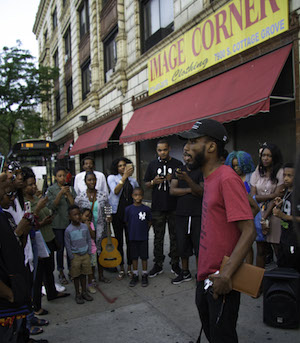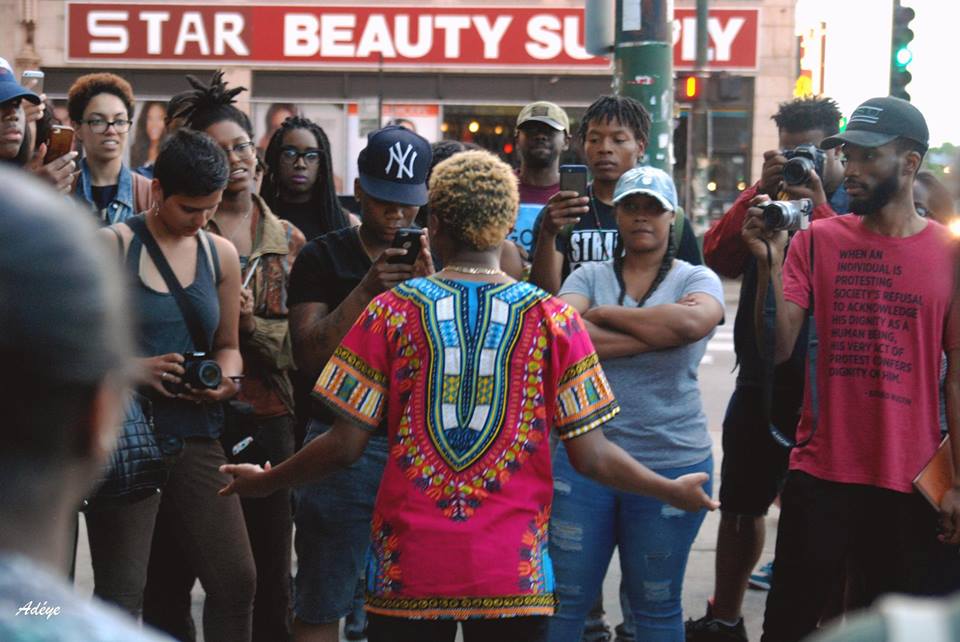As the sun sets on August 8, a crowd begins to gather outside on a corner in Chatham.
At first, it's five people. Then some come in groups off the No. 79 bus; others wander up alone to ask what’s happening. Soon, there are 40 people standing in a circle, watching one man in the middle.
Charles Preston, 26, is a slender black man in a white button-up shirt and brightly patterned pants with a camera around his neck. He’s reading a poem about the exploitation of black suffering as a spectacle for mass consumption.
It is traumatic
that our deaths become viral
we need black power
or in madness we spiral
but black joy
I’mma speak into existence
I'mma give it back to my niggas, I'll replenish
Fuck all these people using our plight as a gimmick
that goes for rappers, movie stars, and politicians
I believe removing glass ceilings can be healing
I believe that showing love makes a huge difference
I believe nothing comes before black women
and I believe we gonna only make it if we’re willing
The crowd snaps and claps their appreciation, and Preston motions for the next artist to step up. As he rejoins the circle, he catches the eye of a few newcomers and points to a crate of fruit on the ground—a humble welcome to #ChurchOnThe9.
The biweekly outdoor open mic is named for its location on the southwest corner of 79th and Cottage Grove. People have rapped, danced, read poetry, and led teach-ins on this corner every other Monday since June 13. Preston, the founder and organizer, says he chose the location to bring attention to the lack of resources for South Side artists, who have few public assembly spots and meager access to economic opportunity.
“I'm frustrated with the segregation of resources in Chicago,” says Preston, who is active in the Save CSU campaign and a former communications chair for activist group BYP100. “It's no secret that in American history, black deaths are public spectacles… But what's not a spectacle is our joy. That’s why I love to amplify resistance.”
For Preston, “church” is as much a concept as a physical place. In the days of slavery, he says, slaves would convene in secret against their masters’ wishes. “They would ditch their plantations and go into a log cabin or a section in the woods, and they all would stand together and sing songs, talk, and read the Bible,” he says. “They were communing.”
But beyond performances, a big part of the open mic is reclaiming the corner.
“I wanted it to be outside, because there's this narrative that people can't go outside because of the violence,” Preston says. “There's also this stigma against black people being on the corner."
The need for such a space in Chatham, once a symbol of black middle-class prosperity and economic mobility, shows just how much the neighborhood has changed since its heyday in the '50s and '60s. Nowadays, the South Side neighborhood is getting more and more name recognition from its native son, Chance the Rapper, who raps about sunny memories of his childhood there as well as the violence that has crept onto its streets. (In "Summer Friends," a track on his latest mixtape, he sings, "79, 79, 79 hey," referencing the street that's become synonymous with the neighborhood—that riff is sampled in Church on the 9 videos.) Much of the crime clusters around 79th Street and Cottage Grove, the two main aisles of commerce.
There have been six gatherings for Church on the 9 at that intersection this summer, and while the number of performers and audience members has been growing, it hasn’t been free of tense moments.
This month, Preston posted a video on Twitter with the caption: “What happens when you host a community open mic at one of the most policed intersections in Chicago.”
What happens when you host a community open mic at one of the most policed intersections in Chicago. #ChurchOnThe9 pic.twitter.com/CNMTFWMzvI
— Kwesi (@BellicoseGarvey) August 5, 2016
The video starts by focusing on a man, who calls himself Brother First, talking about “the sick” people he sees on the street, and how the audience has a "prescription" to help them.
An ambulance in the background sounds its horn—a blip, which Brother First ignores for a moment. Then another, and a voice on a bullhorn saying, “cut the black-on-black fight, now.”
Brother First and Preston exchange a wry glance. “Which is why I’m glad you’re bringing this out here, bro,” Brother First says.
Apparently, two men on the street had begun fighting.
“I guess black lives don’t matter, huh,” shouts someone on a bullhorn. The camera jumps off Brother First and onto the fight, and in a split second, police officers are pulling the men apart and forcing one to the ground.
“One woman was hollering out from across the street at the cops, ‘Don't kill him!’” Preston recalls. The officers eventually let the men go without charges, and the open mic crowd reassembled, shaken by how quickly the situation had escalated. “Some people looked kind of flustered, because of witnessing the police do what they did,” Preston says later. “But I think it showed people why we need to be there. That’s what the corner sees, you know.”
What the corner sees is often the topic of performances at Church on the 9. On August 8, artists tackle prison abolition, police brutality, the water in Flint, gang violence, homophobia, racism, and depression. The words are heavy and the descriptions grim, but the dark mood is broken by frequent bursts of lightness.

The group sings “Happy Birthday” to a woman in a tiara who ends up rapping. Tweak the RBG—radical black girl—gets the crowd clapping for a chant: “One day / we will / be free.”
Also known as Jasamine Harris, the 22-year-old Tweak has been at Church on the 9 since the beginning. She grew up down the street and started rapping at six. “I used to be on 79th literally every day all day, rapping to the guys on the block,” she says. “Growing up, my platform was the block. There wasn’t resources in the hood where I was at—nothing to record music, write music, nothing of that nature. So all I had was beats and writing, and rapping for the people on the block. Rapping they ears off.”
Just as another performer, Benjamin Hart, begins a story about watching a Marlon Riggs film and learning to vogue (“Essex Hemphill was reading a poem. I did not know I had stopped myself from moving this way"), dancing as he speaks, a white-haired woman in a red blazer and pearls runs up to the group—afraid, frantic.
“Excuse me, excuse me,” she cries. “A man is following me and I’m scared of him.”
Once she has the circle’s attention she takes a moment to gather herself. She explains that a man wearing a red shirt had tried to push her against a wall, and that he's attacked her before.
The crowd pauses for a beat, unsure of what to do. Some look at Preston, waiting for an indication of how to respond. Some step forward to try to see the attacker. Those closest to the woman move toward her, protectively enclosing her in the circle.
Then Brother First whispers with Preston for a moment and puts his hand on the woman’s shoulder. He assures her that he’ll talk to the man and make sure she’s safe. He walks her home as Church on the 9 reassembles itself.
“That’s real. Some of our elders can’t even walk home,” says Preston. Then, to Hart: “But you go ahead now, brother."
Later, he reflects, “It's crazy to me how that’s the reality black women live through, walking our blocks. But I do feel good that she called on us to come and stop it. It shows you the type of community we're trying to build—that she felt enough confidence to come to us to do something.”
This report was published in collaboration with City Bureau, a Chicago-based journalism lab.




